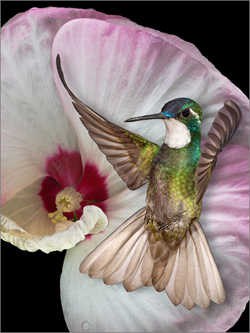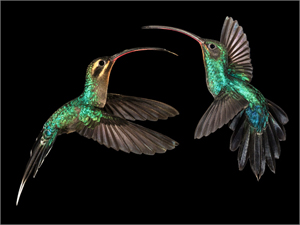Up Close With Cindy Walpole
Cindy Walpole’s award winning photography has been exhibited at the Smithsonian Institute, the Florida Museum of Photography and the San Diego Museum of Natural History where she won best of show at the annual “Best of Nature” photography exhibit. To see more fine art photography by Cindy and her husband Chuck Fritsch, visit FocusFrog.com. In this blog she shared some of her adventures photographing hummingbirds in the tropics. (All images copyright Cynthia Walpole)
“I grew up in the tropical paradise of Costa Rica surrounded by a plethora of exotic plants and animals. Aptly named “The Rich Coast,” it is a Central American country sandwiched between Nicaragua and Panama, a bit smaller than West Virginia. With altitudes varying from sea level to 11,000 feet, with fertile volcanic soil and tropical climate, and varied topography, it provides suitable niches for almost every type of living thing. It is meeting place for flora and fauna of both North and South America, and houses an enormous variety of nature stuffed into one package. It is so small that on a clear day, from the top of the Central Valley’s Irazu Volcano, you can see both the Pacific and the Atlantic Oceans.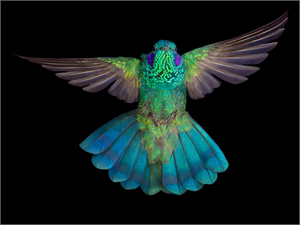
In a fit of temporary insanity, I left behind my family and friends and exchanged the mountains and valleys of Costa Rica for the canyons of New York. I was soon dealing, at a breakneck pace, with the wildlife seen from a Wall Street bond trading desk instead of watching Toucans from my hammock.
Years later, when sanity returned, I turned back to the natural world that had always been a part of me. I found myself, camera in hand, in Africa, Antarctica and lots of places in-between. My passion now is to record and demonstrate the wonderful diversity of nature around us in a way that will lead to its preservation.
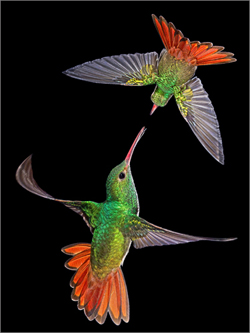 The past three years have been filled with a project involving the hummingbirds of Costa Rica. My husband, Chuck Fritsch, and I go there four times a year, meet up with my brother, Julio Pena, and travel throughout the country trying to find all the different hummingbirds we can. While the eastern part of the United States has only a the Ruby-throated Hummingbird, tiny Costa Rica has nearly fifty different kinds.
The past three years have been filled with a project involving the hummingbirds of Costa Rica. My husband, Chuck Fritsch, and I go there four times a year, meet up with my brother, Julio Pena, and travel throughout the country trying to find all the different hummingbirds we can. While the eastern part of the United States has only a the Ruby-throated Hummingbird, tiny Costa Rica has nearly fifty different kinds.
Just as Wall Street has a set of challenges and problems, so does photographing hummingbirds. We need places that have active feeders so that we can lure the birds into an outdoor studio surrounded with all our equipment. Getting there and then getting back is difficult, as our specialized equipment fills up an SUV.
Last December, we heard the Charming Hummingbird, endemic to southwestern Costa Rica and a small part of Panama might be seen at a lodge with longstanding feeders, and decided it was an opportunity not to be missed.
But how to get there? The drive from our base in San Jose is over eight hours, along bumpy roads with streams which must be forded. When it rains, the roads are impassable.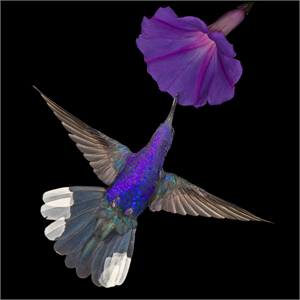
An amateur pilot, friend of Julio, offers his plane for the price of gas. “I need the practice”, he says. When the equipment and people are weighed, it becomes clear that three people and two hundred pounds of equipment in one small plane would not fly. A second friend volunteers his plane. Great, all set!
But we arrive at the airport early one sunny morning to find the pilots hunched over their computer screens. “It is beautiful here,” they explain, “but where we are going, there is a storm”. Although both pilots have been flying since childhood, they are clearly uncomfortable.
We agree to pay for their instrument instructors. All ready, then, four pilots, two planes, three photographers and several suitcases with equipment and yes, one with clothes, for the two week stay.
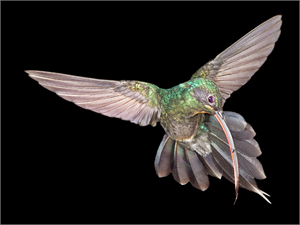 The two planes land safely after a one hour bumpy ride, at an airstrip near the lodge. The lodge is built on a mountain side, overlooking the Pacific Ocean where whales can be seen in the distance. Scarlet Macaws fly underfoot, and they do have hummingbird feeders.
The two planes land safely after a one hour bumpy ride, at an airstrip near the lodge. The lodge is built on a mountain side, overlooking the Pacific Ocean where whales can be seen in the distance. Scarlet Macaws fly underfoot, and they do have hummingbird feeders.
But the feeders have been taken over by Bananaquits. Slightly bigger than hummingbirds, they are aggressive, and persuading them to leave is impossible. The Charming Hummingbird is seen nearby in the bushes, too obstructed by branches to photograph.
We prepare to leave. The next leg of the trip is very short, only ten minutes by plane or, with luck and dry weather, three hours by road. We had planned to use a local bush pilot for the short trip, but he is nowhere to be found. Late on the night of departure, he surfaces and agrees to come the next morning. At 8 am, the lodge owner drives us to the air strip. He takes a long look at the assortment of equipment bags and pronounces: “The plane will not be able to take off.” Julio hurriedly negotiates with the local bus driver, who takes the clothes. The equipment is too valuable.
As these negotiations are concluded, the plane lands. Out comes the local bush pilot. He wearing cowboy boots, a denim shirt unbuttoned to the waist, and a ten gallon hat. He takes a look at the baggage. “No problem, bring the clothes back. We can fit it all.” He rips the back seats off his plane and throws them in the tail. Chuck gets the co-pilot’s seat. I sit behind him. Julio crouches on the floor in an opening between the bags.
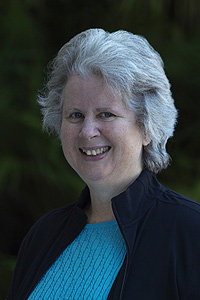 Adventures such as this are what keeps me and my teammates focused on this project. We now have found and photographed more than half of the hummingbirds of Costa Rica. Of course that was the easy half. You can check some of them out on our website but don’t look for the Charming. It isn’t there yet.”
Adventures such as this are what keeps me and my teammates focused on this project. We now have found and photographed more than half of the hummingbirds of Costa Rica. Of course that was the easy half. You can check some of them out on our website but don’t look for the Charming. It isn’t there yet.”
By Cindy Walpole, PWP member photographer
All images copyright Cynthia Walpole


